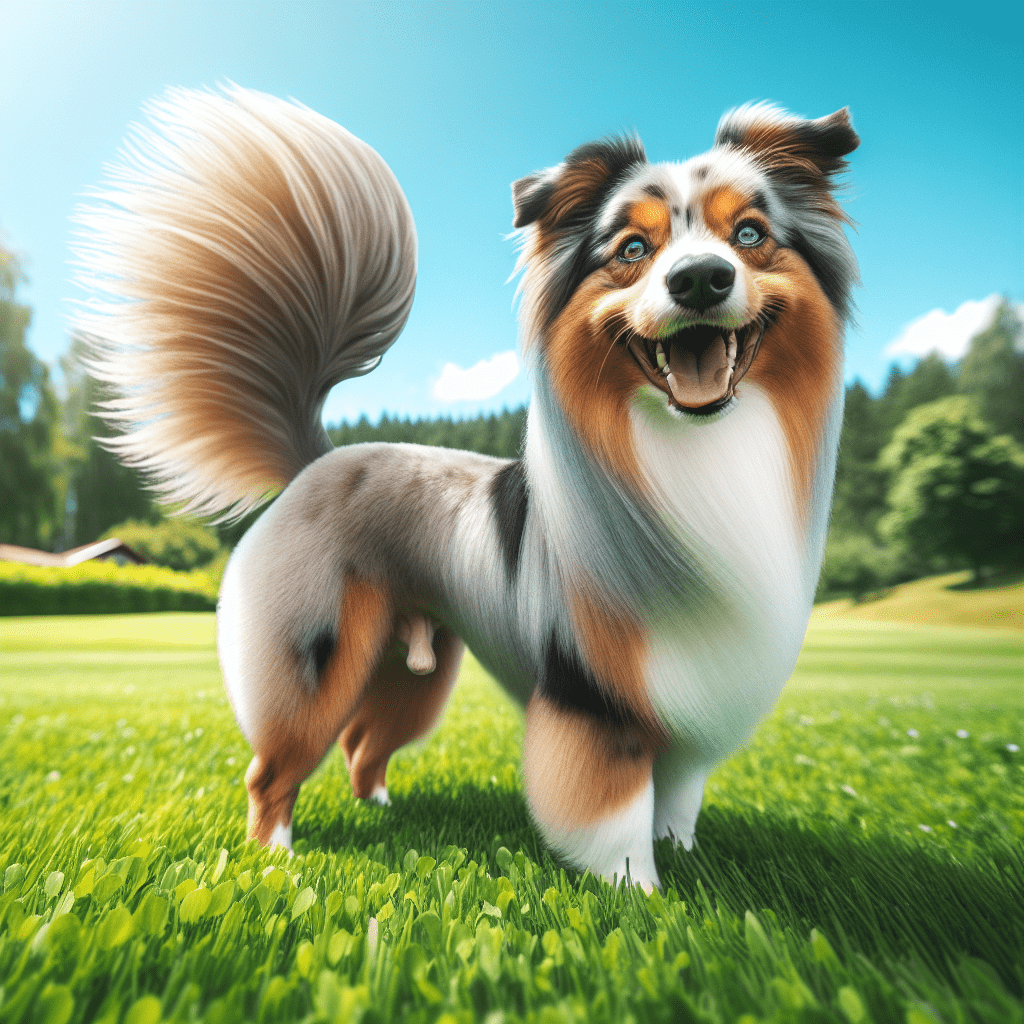The Curious Case of the Bobtail
Have you ever noticed some dogs strutting their stuff with a cute, stubby tail? These canine companions are part of a unique group known for their naturally bobbed tails. But what makes these dogs unique, and why do they have such short tails? In this blog post, we’ll explore the world of bobtail dog breeds, uncover their history, and learn why dog owners and breed enthusiasts love these tail-less wonders.
Table of Contents
A Tail of History and Nature
Bobbed tails in dogs can occur naturally due to a genetic mutation. This differs from docking, a practice where tails are surgically shortened. The natural bobtail mutation has existed for centuries, and certain breeds have carried this trait through generations. In the past, working dogs often favored shorter tails to prevent injuries, especially in rough terrains or during activities like herding or hunting.
Meet the Bobtail Crew
Let’s get acquainted with some of the most popular dog breeds known for their naturally bobbed tails. Each breed has its unique origin, physical traits, and temperament, making it special in its own right.
Australian Shepherd
Despite what their name might suggest, Australian Shepherds come from the US. These clever and energetic pups are known for their intelligence and often have naturally short tails. Originally bred for herding, they’re superstars in agility and obedience competitions.
Pembroke Welsh Corgi
A favorite of the British royal family, the Pembroke Welsh Corgi is known for its adorable appearance and lively personality. Many Corgis are born with naturally short tails, making them look even more charming as they trot around with their characteristic short legs.
Brittany Spaniel
Meet the Brittany Spaniel from France, a do-it-all hunting dog that loves the great outdoors and has a nose that can sniff almost anything. Oh, and their bobbed tails? Natural and super cute. They’re super affectionate, always up for a run, and perfect for families who love to stay active.

Jack Russell Terrier
Did you know Jack Russell Terriers can be born with naturally short tails? True story! These energetic little dynamos were initially bred in England for fox hunting. They’re insanely clever, bursting with energy, and have a natural talent for hunting. And those cute little tails? They’re not just for looks. They’re super practical for wiggling through tight spaces and navigating rough terrain. Jack Russells are a perfect match for active families or anyone who is into a dog that’s always ready for the next adventure.
Schipperke
Meet the Schipperke, the “little black devil” from Belgium! With their fox-like faces and cheeky attitude, they’re one of a kind. These little guys were originally the go-to watchdogs and vermin hunters on canal barges, thanks to their natural bobtails. Don’t let their size fool you, though; Schipperkes are fearless, always alert, and super loyal. They’re perfect for anyone looking for an active, playful buddy. Their unique look and lively personality make them stand out from other bobtail breeds.
Croatian Sheepdog
Did you know about the Croatian Sheepdog? It’s this lesser-known gem of a breed. It is super hardworking and was born with a cute little bobtail. They’ve been the go-to herders in Croatia for centuries, helping out with livestock and all. What makes them stand out is their mix of agility, smarts, and tireless work ethic. That bobtail of theirs? Just one of the many cool things about them. They love being busy and do best when they’re in their element, herding away.
The Great Debate: Natural vs. Docked Tails
The discussion around natural bobbed tails versus docked tails is ongoing, with legal and ethical considerations at play. While natural bobtails result from genetics, docking is a controversial practice banned in many countries. Advocates for animal welfare argue that docking is unnecessary and can be painful for the dog. Potential dog owners should consider these factors and understand the differences between naturally short-tailed dogs and those with docked tails.
Caring for Your Bobtail Buddy
Owning a dog with a naturally bobbed tail requires specific care tips to ensure they stay happy and healthy. Here are a few practical pointers:
Grooming
Keeping your dog groomed is super important, especially for those fluffy breeds with fur around their tails. Remember to keep that area clean and untangled to avoid any nasty discomfort.
Exercise
Bobtail breeds often have high energy levels. Ensure they get plenty of exercise to keep them physically and mentally stimulated. This can include daily walks, playtime, and engaging activities like agility training.
Health Concerns
Some naturally bobbed tail breeds may be prone to specific health issues. Regular vet check-ups are crucial to catch any potential problems early. Be aware of breed-specific concerns, such as hip dysplasia in Australian Shepherds or back issues in Corgis.
Tail Differences
Naturally Bobbed Tails: A naturally bobbed tail is a genetic trait, meaning the dog is born with a short tail or no tail at all. This occurs due to a specific gene mutation that shortens the tail’s length, often seen in breeds like the Australian Shepherd, Pembroke Welsh Corgi, and Brittany Spaniel. The natural bobbing trait is usually inherited, and selective breeding helps to keep this characteristic in certain breeds.
Docked Tails: Docking is a human practice where part of a dog’s tail is surgically removed, typically a few days after birth. This was historically done for working dogs to prevent injury, but it’s now more common for specific breed standards or aesthetic reasons. Unlike natural bobbing, tail docking doesn’t involve genetics and requires veterinary intervention.
Key Differences: Dogs with naturally bobbed tails are born with this trait as part of their genetic makeup, while docked tails are a result of human intervention. In many countries, tail docking is now restricted or banned due to animal welfare concerns, but naturally bobbed breeds retain their short tails without surgical alterations.
Why Bobtail Breeds Make Great Pets
Dog lovers are drawn to naturally bobbed tail breeds for many reasons. Their unique appearance, combined with their lively personalities, makes them stand out. These dogs often form strong bonds with their owners. They can adapt to various lifestyles, whether you’re in the countryside or the city.
Conclusion
Bobtailed dogs have a way of bringing a special kind of happiness to their humans. There’s something about their unique history, their one-of-a-kind looks, and their loving vibes that make them stand out. Thinking about making a bobtail part of your pack? You’re about to join a community of dog lovers who can’t get enough of these tail-less cuties.
Got any tales about bobtail breeds? We’re all ears! Please share your stories, and let’s chat with other dog aficionados. Let’s celebrate the quirky charm of our bobtail buddies together.
Frequently Asked Questions (FAQ)
What is a naturally bobbed tail?
A naturally bobbed tail is a short tail that a dog is born with, resulting from a genetic mutation. Unlike docked tails, which are surgically shortened, naturally bobbed tails are entirely natural and a part of the dog’s unique genetic makeup.
Are naturally bobbed tails considered a breed standard?
In many breeds, naturally bobbed tails are part of the breed standard. For example, in the Australian Shepherd and Pembroke Welsh Corgi, naturally short tails are not only accepted but often desirable traits according to breed standards.
Is there any difference in the health of dogs with naturally bobbed tails compared to those with full-length tails?
Generally, dogs with naturally bobbed tails are as healthy as their long-tailed counterparts. However, it’s always important to monitor any breed-specific health issues affecting your dog, regardless of tail length.
How can one distinguish between a naturally bobbed tail and a docked tail in dogs?
It can sometimes be difficult to distinguish between a naturally bobbed tail and a docked tail just by looking. The dog’s breed history and pedigree typically note a naturally bobbed tail. You can consult a vet or a breed expert for a definitive answer.
Are naturally bobbed tail breeds more prone to injuries?
Dogs with naturally bobbed tails are not necessarily more prone to injuries than dogs with full-length tails. Shorter tails can reduce the risk of tail injuries, especially in working breeds active in rough terrains.
What should I consider before getting a bobtail breed?
Before getting a bobtail breed, consider the dog’s energy levels, grooming needs, and any potential breed-specific health concerns. Ensure you can provide the necessary care and exercise to keep your bobtail buddy happy and healthy.
Is tail docking legal?
Tail docking laws vary by country and region. Cosmetic tail docking is banned or heavily regulated in many places due to animal welfare concerns. Bobbed tails are often preferred as they don’t involve surgical alteration.
Can I participate in dog shows with a bobtail breed?
Yes, many dog shows and competitions accept naturally bobbed tail breeds as long as they meet the breed standards. Always check the specific rules of the event you are entering to ensure your dog is eligible.
We hope these FAQs help answer some of your questions about naturally bobbed-tail dog breeds. If you have more inquiries or need further information, please contact us or join the discussion with fellow dog enthusiasts!
Sarah Smith is a passionate dog and cat enthusiast, blogger, and pet care expert. With years of experience researching and writing about various dog breeds cat breeds, she brings a wealth of knowledge and insight to her blog, PetPession.com. Sarah loves exploring the unique traits, histories, and care needs of different breeds, helping pet owners make informed decisions. Her mission is to create helpful, friendly, and well-researched content that both educates and celebrates the joy of pet ownership. When she’s not writing, Sarah enjoys outdoor adventures with her own furry friends.


7 thoughts on “Top 10 Dog Breeds with Naturally Bobbed Tails”